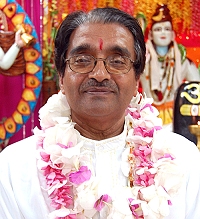From a satsang with Paramacharya of SWAHA, H.H. Pt. Hardeo Persad
In the sacred realm of Hindu spirituality, the tale of Shri Krishna and Mount Goverdhan holds a revered place. The divine leela, or play, unfolds as Shri Krishna extends his benevolent protection over the villagers of Vraj. With the gentle lift of Mount Goverdhan using the little finger of his left hand, he offers them shelter from the enormous deluge of heavy rains. In this remarkable act, Shri Krishna becomes the revered Goverdhan Giridhaari, the guardian of his devotees. The celebration of this divine narrative finds its culmination in the observance of Goverdhan Puja, a cherished tradition that follows the festivities of Divali.
Shri Krishna’s wisdom further illuminates the profound understanding that the Divine Brahm can take on any form. As Shri Krishna, the Supreme Lord, he encourages the villagers to venerate the divine embodiment of Goverdhan, and make their offerings to Him, thereby deepening their faith. In the Bhagavad Gita, Chapter 9, Verse 26, Shri Krishna imparts a timeless revelation: “Whenever a devotee, with a heart full of love, offers me a leaf, a flower, a fruit or water, I appear before them, savouring their devotion.”
These simple devotees, guided by their profound love for Shri Krishna, experienced the divine manifestation and the acceptance of their offerings. It is told that when the Lord reveals himself, he operates in two distinct ways. The first, known as tatastha lakshan, presents him as an ordinary human among humanity, while the second, svarupa lakshan, reveals his true divine nature. This duality is evident when we consider the exploits of Shri Raam and Shri Krishna as they vanquished demonic forces. In the Goverdhan Katha, Shri Krishna initially assumes the role of an inquisitive child, seeking answers from his parents about the festivities in the village. However, in a moment of transcendent revelation, he showcases his essential and superhuman divinity by raising the mountain.
Deep metaphysical implications resonate within this narrative, reaching out to each of us. To unravel the depth of wisdom in Goverdhan Katha, it is essential to grasp that Goverdhan symbolises the mountain of yoga, a realm of mental and spiritual elevation. Analysing the components of the word “Goverdhan,” it consists of “go” signifying ‘senses,’ “var” denotes “a boon” and “dhan” represents “wealth”. This signifies that mastery over the senses leads to spiritual prosperity. Shri Krishna himself stands as the very foundation of yoga, the great Yogi. Lifting this inner mountain necessitates raising the comprehension of the eternal principles residing within our physical being.
The waters of the senses often inundate this mountain of spiritual advancement when our focus remains fixed on worldly affairs. For genuine spiritual progress, it becomes imperative to transcend the influence of our base senses. This mountain, symbolising the union with the Divine, exists within every individual. The ultimate aim of all religious sacrifices is for the individual soul (atma) to merge with the Divine Soul (Paramatma). Through the sincere performance of rituals coupled with an appreciation of their deep significance, we elevate ourselves spiritually.
The symbolism of the five fingers on each hand plays a pivotal role in this discourse. The thumb represents Brahm, the index finger signifies the individual soul (jiva), the middle finger embodies sattvic prakriti, the realm of piety and righteousness, the ring finger embodies rajasic prakriti, the domain of activity and materialism, and the small finger represents tamas prakriti, the state of stillness and non-differentiation. Yogis employ various hand positions called mudras, such as the index finger joined with the thumb while extending the other three fingers, symbolising the transcendence of the three gunas (modes of existence) and the merging of the individual soul with Brahm. The stabilisation of the mind and body in tamas prakriti is imperative for uplifting the mountain of mental advancement.
The term “mountain” (parvat) holds another layer of meaning, signifying the human spine. Within each of us, the subtle body conceals channels of bioenergy: Ida Naadi, Pingala Naadi and Sushumna Naadi, mirroring the Ganga, Jamuna and Saraswati rivers. These channels converge at the ajna chakra, residing in the forehead and paralleling the Indian Triveni confluence of rivers. In the subtle body, seven major chakras await activation, heralding the awakening of Kundalini Shakti, the dormant spiritual power rooted at the base of the spine.
Remarkably, every organ in our body corresponds to various deities: the sun, the moon, Brahma, Vishnu and Shiva, all dwelling within us. Brahm exists within as the soul (atma). Bhagavan Shri Krishna declares in the Bhagavad Gita, Chapter 13, “I am the soul in each person.” Thus, the senses, the indriyas, must be redirected inward, affording us access to our inherent divinity. This, in essence, encapsulates the universal significance of Goverdhan Puja. When Goverdhan is revered, the intellect purifies, the senses transcend sensual desires, and the mountain of yoga ascends. Shri Krishna’s katha serves as a poignant reminder that our journey must lead within; to embark on this voyage of self-discovery, we must delve into the profound truths residing within the human body. Let us collectively beseech Shri Krishna to uplift Mount Goverdhan within each of us.




Jamie
This section examines the individual’s relationship with organized religion, if applicable.